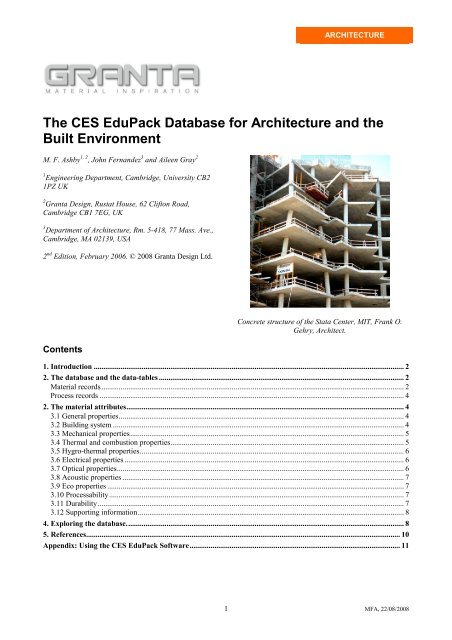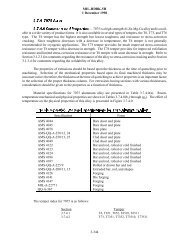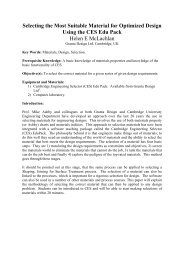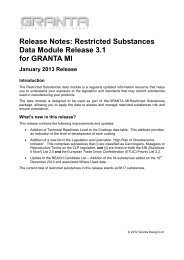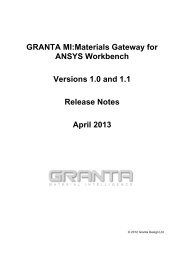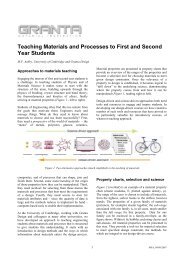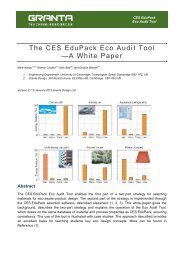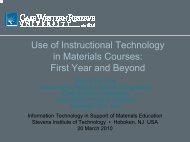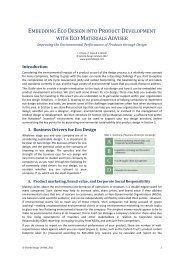The CES EduPack Database for Architecture and ... - Granta Design
The CES EduPack Database for Architecture and ... - Granta Design
The CES EduPack Database for Architecture and ... - Granta Design
Create successful ePaper yourself
Turn your PDF publications into a flip-book with our unique Google optimized e-Paper software.
S<strong>and</strong>stoneS<strong>and</strong>stone is consolidated s<strong>and</strong>particles (quartz), bonded by acementing agent: feldspars, limes, silicaor clays. <strong>The</strong> size of the s<strong>and</strong> particles,the porosity <strong>and</strong> the strength varygreatly in different s<strong>and</strong>stones. <strong>The</strong>colours derive <strong>for</strong>m iron or manganeseimpurities <strong>and</strong> give s<strong>and</strong>stones theircharacter. Particular grades are knownas Bluestone or York stone.S<strong>and</strong>stone is used <strong>for</strong> buildings <strong>and</strong>facing, table tops, bench tops <strong>and</strong>chemical equipment to resist acids <strong>and</strong>alkalis.General propertiesDensity 2.24e3 - 2.65e3 kg/m^3Price * 0.2 - 0.3 $US/kgBuilding systemSuperstructure, Enclosure, Interior, ServicesRed S<strong>and</strong>stone, University of Sydney,New South Wales, AustraliaMechanical propertiesCompressive Strength 70 - 90 MPaTensile Strength * 4 - 15 MPaBending strength 5 - 16 MPaElastic Limit * 4 - 15 MPaFracture Toughness * 0.7 - 1.5 MPa.m^1/2Young's Modulus 14 - 40 GPaShear Modulus * 14.9 - 15.7 GPaBulk modulus * 24.9 - 26.2 GPaBending modulus * 14 - 40 GPaPoisson's Ratio * 0.24 - 0.26Hardness - Vickers * 7 - 38 HVElongation 0 %Endurance Limit * 3.15 - 3.68 MPaMechanical loss coefficient * 1.9e-3 - 5.7e-3Hygro-<strong>The</strong>rmal propertiesWater absorption 2 - 8.5 %Frost Resistance PoorElectrical propertiesElectrical conductor or insulator? Good insulatorAcoustic propertiesSound absorption PoorSound isolation GoodEnvironmental propertiesEmbodied Energy 4.9 - 5.4 MJ/kgCarbon dioxide footprint * 0.14 - 0.16 kg/kgRecycle FalseDowncycle TrueBiodegrade FalseIncinerate FalseL<strong>and</strong>fill TrueDurabilityFresh Water Very GoodSalt Water Very GoodWeak Acid GoodStrong Acid PoorWeak Alkalis Very GoodStrong Alkalis GoodOrganic Solvents Very GoodSunlight (UV radiation) Very GoodDurability in industrial atmosphere GoodDurability in rural atmosphere Very GoodDurability in marine atmosphere Good<strong>Design</strong> guidelinesS<strong>and</strong>stone is easily cut <strong>and</strong> carved. Marble has a wonderful translucency, making it thechoice of many sculptors. It weathers in a benign attractive way, but the surface traps dirt inan urban or industrial environment, requiring periodic cleaning.<strong>The</strong>rmal <strong>and</strong> Combustion properties<strong>The</strong>rmal conductor or or insulator? Poor insulator<strong>The</strong>rmal Resistivity * 0.345 - - 0.398 m.C/W m.K/W<strong>The</strong>rmal Expansion * 7.5 - - 8.5 µstrain/C µstrain/KSpecific Heat * * 840 - - 920 J/kg.C J/kg.KMelting Point * * 1200 1.47e3 - - 1400 1.67e3 C KMaximum Service Temperature * * 400 673 - - 700 973 C KFlammability Non-flammableTechnical notesS<strong>and</strong>stones consist of particles of quartz, feldspar <strong>and</strong> mica bonded by a natural cement.<strong>The</strong> cement determines the strength, durability <strong>and</strong> color. Calcareous s<strong>and</strong>stones arebonded with calcium carbonate; they are called "freestone" because they are easily workedbut they weather badly. Siliceous s<strong>and</strong>stones are bonded with alumino-silicates; they areacid resistant <strong>and</strong> durable but harder to work. Bluestone, much used in New York state, isnoted <strong>for</strong> its even grain <strong>and</strong> high strength. It is about 70% silica bonded with clay.Ferruginous s<strong>and</strong>stones contain oxides of iron, giving lovely browns, reds <strong>and</strong> yellows.Figure 3. Part of a typical Material record, re<strong>for</strong>matted3 MFA, 22/08/2008
Figure 3 shows part of a typical record: here, that <strong>for</strong>s<strong>and</strong>stone. Each property is presented as a range,reflecting the variation that can be expected in its value.<strong>The</strong> units can be toggled between metric, cgs <strong>and</strong>imperial. <strong>The</strong> currency is selectable. <strong>The</strong> propertiesthemselves are defined in Section 3 of this White paper.Process recordsFigure 4 shows the parallel hierarchical organization ofthe Processes data-table (the “process tree”). As in theMaterials data-table, processes are segregated intofamilies, classes, sub-classes <strong>and</strong> members. Eachmember is characterized by a set of attributes: itsproperties. As an example, the Shaping-process familycontains the class ‘Molding’, the sub-class ‘Injectionmolding’ <strong>and</strong> finally the particular member ‘Injectionmolding’. <strong>The</strong> attributes describe its characteristics: thefunction it per<strong>for</strong>ms, the dimensions it can h<strong>and</strong>le, theshapes it can make or join, its economics <strong>and</strong> thematerials to which it can be applied. Like those <strong>for</strong>materials, the process attributes are stored as ranges <strong>and</strong>units are selectable.2. <strong>The</strong> material attributes3.1 General propertiesDensity ρ . <strong>The</strong> density is the weight per unit volume,<strong>and</strong> thus has units of kg/m 3 or lb/in 3 . It is this that isstored in the database.(<strong>The</strong> Specific gravity is the density divided by that ofwater (1000kg/m 3 ), <strong>and</strong> is dimensionless. Its value isDensity/1000.)Price P (units: US$/lb, Euros/kg, £/kg – selectable). <strong>The</strong>price of materials depends on many factors, amongthem the influence of supply <strong>and</strong> dem<strong>and</strong>, the amountyou wish to purchase <strong>and</strong> the relationship you have withyour supplier. <strong>The</strong> prices of commodity materials givenin the database are derived from London MetalExchange, Bullion Market <strong>and</strong> Commodity Marketvalues. Where this is not possible prices are derivedfrom a price model. Prices are regularly updated.3.2 Building systemSuperstructure. <strong>The</strong> superstructure is the collection ofelements - columns, beams, slabs <strong>and</strong> other components- that transfer static <strong>and</strong> dynamic loads from thebuilding down to the foundation (or the substructure).Most building superstructures are hidden from view,covered by interior <strong>and</strong> exterior finish materials. Othersuperstructures are an integral aspect of the architectureof the building, such as the Eiffel Tower or the CentrePompidou, both in Paris.Enclosure. <strong>The</strong> enclosure includes all components thatcontribute to a durable <strong>and</strong> reliable weather barrierbetween the ever changing exterior climate <strong>and</strong> the need<strong>for</strong> a stable interior environment. Windows, doors,vapor <strong>and</strong> air barriers, brick masonry, wood siding,copper flashing <strong>and</strong> many other components areassembled together to control the flux resulting from airpressure, water vapor <strong>and</strong> thermal gradients between theinside <strong>and</strong> the outside. In addition, the enclosure is the‘face’ of a building <strong>and</strong> thus plays an importantsymbolic role – the façade of the White House inWashington DC or that of the Houses of Parliament inLondon certainly communicate this aspect of theenclosure.Interior. <strong>The</strong> interior building system includes all of thenon-structural components that spatially define thehabitable space of buildings such as floor assemblies<strong>and</strong> surfaces, ceilings <strong>and</strong> wall materials, partitions,interior glazing, doors <strong>and</strong> other space-definingelements. Interior systems, while mostly functionalassemblies, can be gr<strong>and</strong> <strong>and</strong> symbolically powerful,such as the vault of the constellations of Gr<strong>and</strong> CentralTerminal in New York City or the main hall of anylarge Opera House.Services. <strong>The</strong> building services are a set of elements thatprovide a constant stream of air, heating <strong>and</strong> cooling,electricity, water <strong>and</strong> data delivered from central utilityplants within the building to all spaces within theinterior volume. This diverse group of componentsincludes metal ducts to deliver heated or cooled air,copper <strong>and</strong> PVC plumbing to transport water, insulatedcopper wiring, glass optical fiber cables, etc. <strong>and</strong> manyFigure 4. <strong>The</strong> organizational structure of the Processes data-table4 MFA, 22/08/2008
kinds of devices that serve these delivery systemsincluding, chillers, boilers, pumps, valves, etc. <strong>The</strong>sesystems are material intensive, requiring not only allkinds of metals <strong>and</strong> ceramics to store <strong>and</strong> deliver water<strong>and</strong> air but a great variety of polymers <strong>and</strong> composites<strong>for</strong> seals, adhesives, gaskets <strong>and</strong> other joint conditions.3.3 Mechanical propertiesStrength is measured in many ways depending on thenature of the applied <strong>for</strong>ce <strong>and</strong> the family to which thematerial belongs. All have units of MPa in the Metricsystem, 10 3 psi in the Imperial system.Elastic Limit σ el is the stress at which it first sufferspermanent (inelastic) de<strong>for</strong>mation in tension.Compression strength σ c is the stress at which it firstsuffers permanent (inelastic) de<strong>for</strong>mation incompression.Bending strength σ b is the stress at which it firstsuffers permanent (inelastic) de<strong>for</strong>mation in bending.Tensile Strength σ ts is the nominal stress at which around bar of the material, loaded in tension separates.For brittle solids – ceramics, glasses <strong>and</strong> brittlepolymers – it is equal to the elastic limit. For metals,ductile polymers <strong>and</strong> most composites it is larger thanthe elastic limit by a factor ranging from 1.1 to 3.Fracture toughness K c , is a measure of the resistance ofa material to the propagation of a crack. It can bemeasured by loading a sample containing a deliberatelyintroducedcrack of length 2c <strong>and</strong> then recording thetensile stress σ at which the crack propagates.K c = Yσπ cwhere Y is a geometric factor, near unity, whichdepends on details of the sample geometry.Moduli measure stiffness. All have units of GPa in theMetric system, 10 6 psi. or 10 3 ksi in the Imperial system.Young's modulus E is the slope of the initial, linearelasticpart of the stress-strain curve in tension orcompression.Shear modulus G is the slope of the initial, linearelasticpart of the stress-strain curve in shear.Bulk modulus K is the slope of the initial, linear-elasticpart of the stress-strain curve under hydrostatic pressure.Bending modulus E b is the modulus measured inflexure. For isotropic materials it is the same as Young’smodulus, but <strong>for</strong> anisotropic materials like plywood,chipboard, GFRP <strong>and</strong> CFRP it differs from E.Hardness H is measured by pressing a spherical ordiamond-shaped indenter into the surface of thematerial. <strong>The</strong> unit of hardness in the SI system is MPa,but it is seldom quoted in these units. <strong>The</strong> commonestmeasure is Vickers hardness H v , <strong>and</strong> that is what is usedhere (H v = Hardness in MPa/10), but Brinell <strong>and</strong>Rockwell hardnesses are also used. <strong>CES</strong> in depth givesconversion tables.Elongation ε is the extension in the length of a tensilespecimen at fracture, expressed as a percentage of theoriginal gauge length ε = ( Lx− Lo) / Lowhere L 0 isthe original gauge length <strong>and</strong> L x is the final gaugelength.Endurance limit σ e is defined as the maximum appliedcyclic stress amplitude <strong>for</strong> an 'infinite' fatigue life.Generally 'infinite' life means more than 10 7 cycles tofailure. It is typically 0.2 to 0.5 times the tensilestrength.Mechanical loss coefficient η measures the degree towhich a material dissipates vibrational energy. It isdimensionless.3.4 <strong>The</strong>rmal <strong>and</strong> combustion properties<strong>The</strong>rmal resistivity R is the rate at which heat isconducted through a solid at 'steady state' (meaning thatthe temperature profile does not change with time) isgoverned by the thermal conductivity λ. It is measuredby recording the heat flux J (W/m 2 ) flowing fromsurface at temperature T 1 to one at T 2 in the material,separated by a distance X:T2 T1J = − λ−X<strong>The</strong> thermal resistivity is the reciprocal of the thermalconductivity. Its units are m.K/W, or h.ft.F/Btu.<strong>The</strong>rmal expansion coefficient α . Most materialsexp<strong>and</strong> when they are heated. <strong>The</strong> linear thermalexpansion coefficient α is the thermal strain perdegree K (Metric units: µstrain/K; Imperial: µstrain/F).Specific Heat C p is the specific heat capacity at constantpressure. It specifies the amount of heat required to raisethe temperature of 1 kg of material by 1°C (K). It ismeasured by the st<strong>and</strong>ard technique of calorimetry(Metric units: J/kg.K; Imperial: Btu/lb.F).<strong>The</strong> Melting point T m is the temperature at which amaterial turns abruptly from solid to liquid. <strong>The</strong> meltingtemperature of an alloy is usually less than the meltingtemperature of the parent metals.5 MFA, 22/08/2008
<strong>The</strong> Glass temperature T g is a property of noncrystallinesolids that do not have a sharp melting point.It characterises the transition from true solid to viscousliquid in these materials. Semi-crystalline plastics haveboth T m <strong>and</strong> T g . T m refers to the melting of thecrystalline component <strong>and</strong> T g refers to softening of theamorphous component. Amorphous plastics have no T m ,only a T g .<strong>The</strong> Maximum service temperature T max is the highesttemperature at which the material can reasonably beused in a load-bearing component without oxidation,chemical change or excessive creep becoming aproblem. T max is typically T m /3 <strong>for</strong> Metals <strong>and</strong> T m /2 <strong>for</strong>Ceramics. For Polymers, T max is more narrowly definedas the maximum service temperature <strong>for</strong> long-term,continuous use. Where data is available, it is the rangeof the three UL 764 relative thermal index (RTI) tests.Flammability. <strong>The</strong> flammability of building products isdefined by the Flame Spread Classification of amaterial. To determine the Flame Spread Classification(FSC) of a material, burners are ignited <strong>and</strong> the advanceof the flame front along the test specimen is recorded<strong>for</strong> ten minutes. <strong>The</strong> FSC of noncombustible materialsis zero, <strong>and</strong> that of red oak is 100. <strong>The</strong> values <strong>for</strong> allother products are determined in comparison with thesematerials. ASTM E 1264 defines three ranges thatcorrespond directly to building Classes I, II <strong>and</strong> III:Class A: 0-25, Class B: 26-75 <strong>and</strong>, Class C: 76-100.Here we rank flammability on a 3-point scale as Nonflammable,Self-extinguishing <strong>and</strong> Flammable.3.5 Hygro-thermal propertiesWater absorption is defined here as the increase in massas a result of moisture absorption when a major surfaceof a specimen is placed in contact with liquid water.Water vapor permeability is defined here as the mass ofwater vapor transmitted in unit time, under unit pressuredifference, through a unit area of material of unitthickness. This database uses values quoted <strong>for</strong> relativehumidity of 50% <strong>and</strong> room temperature. (Metric units:kg/m.s.Pa; Imperial: lb/ft.s.in.Hg). A number ofdatabases include rate of permeability values that use SIunits of nanograms of water per second <strong>for</strong> each squaremeter of area divided by the Pascals of vapor pressuredifference per thickness in meters.Air permeability is the mass of air transmitted in unittime, under unit pressure difference, through a unit areaof material of unit thickness. (Metric units: kg/m.s.Pa;Imperial: lb/ft.s.in.Hg).Frost resistance. Resistance to water absorption is themost important aspect of resisting damage due to freezethawcycles. Brittle <strong>and</strong> porous materials, such as limemortars, brick <strong>and</strong> concrete, may be critically damagedby absorbing liquid water that then freezes <strong>and</strong> exp<strong>and</strong>swithin the solid. Here we rank Frost resistance on a 5-point scale ranging from Very good to Very poor.3.6 Electrical properties<strong>The</strong> Electrical resistivity ρ e is the resistance of a unitcube of the material. Its units in the SI system are Ω.mbut it is usual in both Metric <strong>and</strong> Imperial notation touse µΩ.cm. Its value varies over an immense range:from a little more than 1 in units of µΩ.cm <strong>for</strong> goodconductors, to more than 10 24 , in the same units, <strong>for</strong> thebest insulators. <strong>The</strong> electrical conductivity is simply thereciprocal of the resistivity.Dielectric constant (dimensionless). When a material(such as that used in a capacitor) is placed in an electricfield, it becomes polarized <strong>and</strong> charges appear at itssurfaces that tend to screen the interior from the externalfield. <strong>The</strong> tendency to polarize is measured by thedielectric constant. For polymers, the dielectric constantis generally recorded in the frequency range 50–1000 HzDielectric loss tangent (dimensionless). When analternating voltage (V) is applied to a 'perfect' dielectric,current (I real ) flows that is 90° out of phase with thevoltage. No insulating material is perfect, <strong>and</strong> a degreeof polarization occurs, with the result that the currentleads the voltage by something less than 90°.Polarization involves the movement of charged particles(electrons, ions, or molecules which carry a dipolemoment). In an oscillating external field, the chargedparticles move between two alternative configurations,<strong>and</strong> in doing so they dissipate energy.<strong>The</strong> breakdown potential is the electric potentialgradient at which the resistance of an insulator breaksdown, <strong>and</strong> a damaging surge of current flow through thespecimen. It is measured by increasing, at a uni<strong>for</strong>m rate(60 Hz) , an alternating potential applied across a plateof the material until breakdown occurs (Units:Metric: MV/m; Imperial: V/mil).3.7 Optical propertiesTransparency is described by four ratings:• Optical quality – outst<strong>and</strong>ing transparency,suitable <strong>for</strong> lenses <strong>for</strong> imaging.• Transparent – good transparency though withsome slight loss of optical clarity.• Translucent – diffuse light is transmitted butlacking optical clarity• Opaque – Completely non-transparent.<strong>The</strong> dimensions <strong>and</strong> processing of a polymer can affectits transparency. For instance, many polymers aretranslucent with a thin section thickness but opaquewhen the section thickness is increased. In assigning6 MFA, 22/08/2008
Transparency ratings we have attempted to reflecttypical conditions.Refractive index a dimensionless property defined asthe ratio of the speed of light in vacuum to that in thematerial.Transmissivity is a measure of the optical transparencyof a material. Transmissivity is the proportion ofradiation in the visible light range (380-780 nm) thatpasses through a material.Emissivity is a measure of the heat radiation emitted bya material. An ideal black body is assigned anemissivity of 1.0. <strong>The</strong> emissivity is highly dependent onthe surface condition of the material – whether it ispolished, painted or coated. Here we refer to theemissivity of the material in its natural state.Natural Color is a description of the natural color <strong>and</strong>appearance of the material, without the application ofpaints or dyes.3.8 Acoustic properties<strong>The</strong> Sound absorption coefficient measures theproportion of incident sound that is absorbed by amaterial. A material with a coefficient of 0.8 absorbs80% of the sound; one with a coefficient 0.03 absorbsonly 3%, <strong>and</strong> thus is a sound reflector.Sound insulation measures the effectiveness of amaterial in preventing airborne noise entering a room,either from outside or from another room. It is almostproportional to the mass, per unit area, of the wallthrough which the sound must pass, <strong>and</strong> thus the density<strong>and</strong> thickness of the material.<strong>The</strong> Sound isolation coefficient measures theeffectiveness of a material in preventing vibrationtransmission through the structure members of abuilding. Typical isolation materials, such as rubber,wood or mineral wool, interrupt the path of sound in anotherwise rigid structure.3.9 Eco propertiesEmbodied energy is the energy required to make 1 kg ofthe material from its ores or feedstocks. Data areapproximate, but still useful in ranking materials by theenergy they have required. Many materials are veryenergy intensive to produce (Metric units: MJ/kg;Imperial: kcal/lb).Recycle, Downcycle, Biodegrade, Incinerate, L<strong>and</strong>fillsimply record whether or not the material can beprocessed in these ways.3.10 ProcessabilityProcessing by casting, <strong>for</strong>ming, molding, machining,welding <strong>and</strong> brazing is ranked on a scale of 1 to 5. <strong>The</strong>ranking 1 indicates that the process is impractical; 5indicates that it is routine <strong>and</strong> can be per<strong>for</strong>med withoutdifficulty. Rankings of 2 to 4 indicate increasing levelsof ease of processing.Castability deals with a complex combination of liquidmetal properties <strong>and</strong> solidification characteristics thatpromote a sound <strong>and</strong> accurate casting. Factors ininclude fluidity, shrinkage <strong>and</strong> resistance to hot tearing.Formability describes the ability of sheet metal to bede<strong>for</strong>med to shape. It is limited by tearing, buckling,wrinkling or excess thinning. Good <strong>for</strong>mability meansgood resistance to these failure modes.Moldability is an indicator of the ease with which apolymer can be moulded.Machinability is the relative ease of difficulty of amaterial to be machined. A material has goodmachinability it the tool wear is low, the cutting <strong>for</strong>cesare low, the cutting speed is high <strong>and</strong> the surface finishis good.Weldability describes the ease or difficulty with which aweld can be made <strong>and</strong> the quality <strong>and</strong> soundness of theresulting joint.Solder/Brazability describes the ease or difficulty withwhich a a material can be brazed or soldered <strong>and</strong> thequality <strong>and</strong> soundness of the resulting joint.3.11 DurabilityOf the material exposed to a number of st<strong>and</strong>ardoperating environments is categorized qualitatively on a5-point scale: Very poor, Poor, Average, Good, <strong>and</strong>Very good. . 'Very good' means highly resistant to theenvironment, 'Very poor' means completely unresistantor unstable in the environment. <strong>The</strong> categorization isdesigned to help with screening; further in<strong>for</strong>mationshould always be sought if environmental attack is aconcern. <strong>The</strong> environments are:Fresh WaterWeak AlkalisCO 2 footprint. <strong>The</strong> mass of carbon dioxide (CO 2 ), in kg,produced <strong>and</strong> released into the atmosphere, as aconsequence of the production of one kg of the material.Metric: kg/kg; Imperial: lb/lbSalt WaterWeak AcidStrong AcidStrong AlkalisOrganic SolventsSunlight(UV radiation)7 MFA, 22/08/2008
Durability in industrial atmosphere. Along with marineatmospheres, industrial atmospheres represent achallenging environment <strong>for</strong> the durability of buildingcomponents. <strong>The</strong> combination of airborne particulates<strong>and</strong> acidic discharges from industrial sites can be themost damaging elements that a building’s componentsmay face during their service life. Especially vulnerableare metals used as building enclosure cladding, flashing,railings, fascias, <strong>and</strong> soffits.Durability in rural atmosphere. Rural atmospherescontain few challenges to the durability of buildingcomponents, there<strong>for</strong>e this particular context is leastdamaging to a building’s overall service life.Durability in marine atmosphere. <strong>The</strong> prevalence ofsalts, high humidity, exposure to storms <strong>and</strong> high windsmake marine environments a challenging context <strong>for</strong>many buildings. Hurricanes <strong>and</strong> high-energy storms areonly the most dramatic events that pose real risk to theservice life of building components. Continual wetting<strong>and</strong> drying of surfaces with salt saturated water <strong>and</strong>intense solar radiation can be just as damaging over thelifetime of the building.3.12 Supporting in<strong>for</strong>mationPoints the user to additional in<strong>for</strong>mation about thematerial. It is cataloged under the following headings.<strong>Design</strong> guidelines contains advice about design with thematerial.Technical notes give further technical backgroundabout the material.Typical uses lists common applications of the material.Related st<strong>and</strong>ards refer to st<strong>and</strong>ards where these arerelevant.Trade names is a list of alternative names.Further reading lists further sources of in<strong>for</strong>mationabout the material.Links to References lists sources of in<strong>for</strong>mation aboutthe material.Links to Suppliers list suppliers of the material.Links to ProcessUniverse retrieves records <strong>for</strong>processes that can shape, join or surface-finish thematerial.4. Exploring the database<strong>The</strong> <strong>CES</strong> <strong>EduPack</strong> software allows three principalfunctions: Browsing, Searching <strong>and</strong> Selection. Browseopens the chosen data-table (that of Materials or ofProcesses), <strong>and</strong> allows the tree to be exp<strong>and</strong>ed until achosen record is exposed. <strong>The</strong> Search facility enables afull-text search of all the records in a chosen data-table,or all of them. In addition, the <strong>CES</strong> <strong>EduPack</strong> systemoffers a range of Selection tools, allowing materials tobe chosen to meet specific needs.Figures 6, 7 <strong>and</strong> 8 are examples of the ways in whichthe data can be presented. Figure 6 is bar-chart, here <strong>for</strong><strong>The</strong>rmal resistivity.Figure 6. A bar chart of thermal resistivity.8 MFA, 22/08/2008
Figure 7. A bubble chart of thermal resistivity <strong>and</strong> density.Figure 8. <strong>The</strong> thermal conductivities <strong>and</strong> embodied energies of materials.9 MFA, 22/08/2008
Each bar shows the range of the property <strong>for</strong> a material.Materials with high, low or specific values of thermalresistivity are selected by placing a selection box (nowshown) on the chart. All the numeric properties in thedatabase can be plotted <strong>and</strong> selected in this way.Selection stages can be stacked to meet multiple criteria.Figure 8 shows a more in<strong>for</strong>mative chart, one givinginsight into energy-related aspects of material choice.<strong>The</strong> embodied energy of materials is plotted on the x-axis – it allows a measure of the material-related energycommitment in construction. <strong>The</strong> <strong>The</strong>rmal resistivity<strong>and</strong> Conductivity are plotted on the y-axis – highresistance implies the ability to insulate, one way ofconserving energy during the use of the structure.Materials that have low embodied energy <strong>and</strong> highthermal resistivity lie at the lower left. Not surprisingly,Straw bale construction (see the record <strong>for</strong> Straw bale)is particularly good by both measures. As in Figure 7,materials of a given family cluster together; in Figure 8families have been enclosed in envelopes to bring thisout.All the numeric properties can be plotted in this way,<strong>and</strong> (as with the bar-charts) a range of selection toolsallow materials lying in a particular part of the charts tobe isolated <strong>and</strong> identified.5. ReferencesAshby, M. F. (2005) “Materials Selection in Mechanical<strong>Design</strong>” 3 rd edition, Butterworth Heinemann, Ox<strong>for</strong>dUK (ISBN 0-7506-6168-2).Ashby, M.F. <strong>and</strong> Johnson, K.J. (2004) “Materials <strong>and</strong><strong>Design</strong>”, Butterworth Heinemann, Ox<strong>for</strong>d UK (ISBN 0-7506-5554-2).<strong>CES</strong> 2006 <strong>Architecture</strong> <strong>and</strong> Building MaterialsSoftware, <strong>Granta</strong> <strong>Design</strong>, Cambridge 2006.(www.<strong>Granta</strong>design.com).Fern<strong>and</strong>ez, J.E. (2006) “Material <strong>Architecture</strong>: emergentmaterials <strong>for</strong> innovative buildings <strong>and</strong> ecologicalconstruction”, Architectural Press, Ox<strong>for</strong>d UK (ISBN 0-7506-64975).Trechsel, H.R. (2001) “Moisture Analysis <strong>and</strong>Condensation Control in Building Envelopes”, ASTM,West Conshohocken, USA (ISBN 0-8031-2089-3).10 MFA, 22/08/2008
Appendix: Using the <strong>CES</strong> <strong>EduPack</strong>SoftwareThis Appendix presents a brief tutorial in the use of the<strong>CES</strong> <strong>EduPack</strong> selection system<strong>The</strong> “Browse” <strong>and</strong> “Search” facilitiesFigure A1 shows the main toolbar <strong>and</strong> its three principalfunctions: Browse, Select <strong>and</strong> Search. <strong>The</strong> figure showshow two of these work. Browse opens the chosen datatable(that of Materials or of Processes), <strong>and</strong> allows thetree to be exp<strong>and</strong>ed until a chosen record is exposed.Double clicking on the record name opens the record.<strong>The</strong> Search facility enables a full-text search of all therecords in a chosen data-table, or all of them. A textstringis entered in ‘Find what?’ box <strong>and</strong> the desireddata-table chosen via the ‘Which table?’ box. <strong>The</strong>search then seeks any record that contains, anywherewithin it, the text-string.<strong>The</strong> “Select” facilities<strong>The</strong> <strong>CES</strong> <strong>EduPack</strong> software offers a range of selectiontools, allowing materials to be chosen to meet specificneeds. Figure A2 show the simplest: a ‘Limit stage’.Selecting this option opens a dialog box in which theattributes of a record are listed (the figure shows only asmall subset of these). <strong>The</strong> user can insert desired upperor lower limits on numeric properties <strong>and</strong> select desiredBoolean characteristics, as shown. Any number ofconstraints (the limits) can be applied. <strong>The</strong> materialsthat meet them all are listed in the Results window at thelower left.An alternative, useful both <strong>for</strong> presentation of data <strong>and</strong><strong>for</strong> selection, is shown in Figure A3. It is a ‘Graphstage’. This option opens a dialog box that allows axesto be chosen on which attributes are plotted. Thusselecting “<strong>The</strong>rmal resistivity” <strong>for</strong> the y-axis alone givesa bar chart on which the value of resistivity is plotted asa bar <strong>for</strong> each of the materials in the data-table, asshown earlier as Figure 6. <strong>The</strong> length of the bar reflectsthe range of the property.Choosing a property <strong>for</strong> both the x- <strong>and</strong> the y-axis givesa bubble chart. Thus choosing ‘Density’ <strong>for</strong> the x-axis<strong>and</strong> ‘<strong>The</strong>rmal resistivity’ <strong>for</strong> the y-axis gives the chartshown earlier as Figure 7, in which the width of eachellipse reflects the range of density <strong>and</strong> the height therange of resistivity <strong>for</strong> each material in the data-table.Box <strong>and</strong> line selection tools appear above the charts (notshown), allowing materials that lie in chosen areas of achart to be selected.Figure A4 shows a third selection tool: a ‘Tree stage’.With it, the selection can be limited to a chosen segmentof the Materials or Process tree. Thus opening theMaterials tree that appears in the dialog box allows asubset of materials – here, steels, with in the family ofmetals – to be chosen: all subsequent selection stagesnow apply only to steels; all other classes are excluded.If, instead, the Process tree is chosen, it becomespossible to limit the selection to materials that can beprocessed in certain ways – in the figure, the selection islimited to materials that can be shaped by a moldingoperation.Figure A2. <strong>The</strong> <strong>CES</strong> toolbar, showing the SELECT facility. It is used here to open a Limitstage to select materials that have an elastic limit above 100 MPa, a service temperatureabove 200 C <strong>and</strong> that are good electrical insulators.11 MFA, 22/08/2008
Selection stages can be stacked; the records listed in theResults window are those that have passed all thestages. <strong>The</strong> charts can be customized, the bars <strong>and</strong>bubbles labeled with the material name (by clicking onthem) <strong>and</strong> headings <strong>and</strong> titles can be added. Records,charts <strong>and</strong> results can be copied (Edit – Copy…just as ina word processing package) <strong>and</strong> Pasted into a Worddocument or a drawing package such as AdobeIllustrator, where they can be re<strong>for</strong>matted <strong>and</strong> edited toenhance them further. Figures 6, 7 <strong>and</strong> 8 of the havebeen enhanced a little in this way.Figure A3. A Graph stage allow data to be plotted as bar-charts or bubble charts. Selectionlines <strong>and</strong> boxes are used with the charts to select materials with chosen combinations ofproperties.Figure A4. A Tree stage allows the selection to be limited to a chosen family or class ofmaterials, as in the upper schematic (here, steels), or to materials that can be processed in aparticular way, as in the lower schematic (here, materials that can be molded).12 MFA, 22/08/2008


